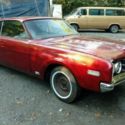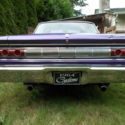1968 Mercury Cyclone
- Price:
- Location: San Antonio, Texas, United States
- Condition: Used
- Make: Mercury
- Model: Other
- Type: Fastback
- Trim: Cyclone GT
- Year: 1968
- Mileage: 23,378
- VIN: 8H15S558854
- Color: Red
- Engine size: 390
- Number of cylinders: 8
- Power options: Air Conditioning
- Fuel: Gasoline
- Transmission: Manual
- Drive type: RWD
- Interior color: Red
- Options: Leather Seats
- Vehicle Title: Clear
1968 Mercury Other Description
he Cyclone received Mercury’s biggest facelift in 1968, switching from 1967’s boxy, Fairlane-derived coupe body to the super-streamlined Torino-based fastback. Unfortunately, the Cyclone GT lost the 335-hp, 390-cdi V-8 as its standard engine, instead replaced by the 210-hp, 302-cid V-8. No matter, though, as the fastback was handsome and could be equipped with a 230-hp 302, 265- or 325-hp 390-cid V-8s, (briefly) a 390-hp version of the 427-cid V-8, or a 335-hp, 428-cid V-8.
The Mercury Cyclone Spoiler and the Ford Torino Talladega launched the NASCAR streamliner battle
Mercury Cyclones occupy an interesting niche in the muscle car world. The car is a fantastic expression of American muscle, albeit one from a mid-level, luxury-oriented nameplate. As a result, the Cyclone is mostly overshadowed by the Ford Mustang and Torino. The Cyclone’s sleeper status makes it a great value, and most cars remain within reach of any buyer. As with any muscle car of the era, the importance of documentation in terms of market price rises exponentially as the car’s horsepower ratings climb.
The Mercury Cyclone is an automobile produced by the Mercury division of the Ford Motor Company from 1964 to 1971. It started as a performance model of the 1964 Mercury Comet, and was named the Mercury Comet Cyclone through 1967. For 1968, the "Comet" part of the name was dropped. Options such as GT, Spoiler and Cobra Jet were added
The Cyclones had a mid tire level body tape stripe. The Cyclone GT's had an upper level body stripe, buckets, wide whitewall tires, special wheel covers, all vinyl interior, and the special handling package. It was named the fastest car of that year,[how?] because it set a world record speed of 189.22 mph (304.52 km/h) at Daytona.[clarification needed]
This Cyclone is power by a 390 cu in (6,391 cc) optional engine (standard for GT) with a four-barrel carburetor, which generated 325 hp (242 kW). The 4 speed transmission works flawlessly, as do the accessories such a power steering, power brakes and air conditioning.
 1968 Mercury Cyclone GT
1968 Mercury Cyclone GT
Mileage: 99,999
 1968 Mercury Cyclone 390 GT
1968 Mercury Cyclone 390 GT
Mileage: 37,222
 1968 Mercury Cyclone Base 6.4L
1968 Mercury Cyclone Base 6.4L
Mileage: 53,897
 1968 Mercury Cyclone Fastback
1968 Mercury Cyclone Fastback
Mileage: 94,135
 1968 Mercury Cyclone GT Original Condition
1968 Mercury Cyclone GT Original Condition
Mileage: 102,142
 1968 Mercury Cyclone 2 door coupe,
1968 Mercury Cyclone 2 door coupe,
 1964 Mercury Comet Cyclone Factory 4 speed 289 4V Carb solid true cyclone clean
1964 Mercury Comet Cyclone Factory 4 speed 289 4V Carb solid true cyclone clean
Mileage: 124204
 1968 Mercury Cyclone GT 390 4v Automatic (no engine or Trans)
1968 Mercury Cyclone GT 390 4v Automatic (no engine or Trans)
Mileage: 77,128
 1968 Mercury Cyclone GT Automatic Original Survivor Car
1968 Mercury Cyclone GT Automatic Original Survivor Car
Mileage: 97000













 1968 Mercury Cyclone Fastback, 302ci 4v, Air Conditioning
1968 Mercury Cyclone Fastback, 302ci 4v, Air Conditioning